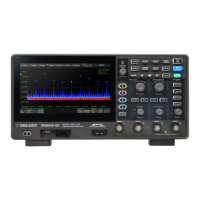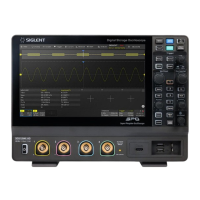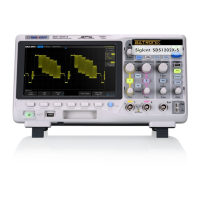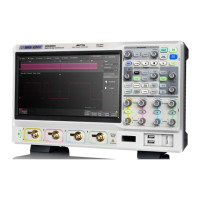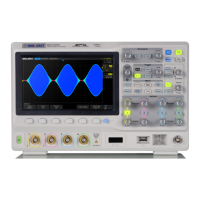Do you have a question about the SIGLENT SDS814X HD and is the answer not in the manual?
Describes how to turn the oscilloscope on using manual or auto power.
Procedures for safely turning off the oscilloscope.
Explains the controls for adjusting vertical scale and offset.
Details on controls for horizontal scale, roll, and zoom.
Explains the front panel trigger controls and modes.
Function of the Run/Stop button for controlling data acquisition.
How the Auto Setup button optimizes waveform display settings.
Controls for activating and adjusting cursors for measurements.
Detailed settings for vertical scale, offset, and other channel parameters.
Setting up trigger conditions via quick menu and dialog box.
Setting the trigger level for analog and digital triggers.
Explains trigger modes like Auto, Normal, Single, and Force.
Overview of various trigger types supported by the oscilloscope.
Configuring edge triggers based on rising, falling, or alternating edges.
Setting slope triggers based on transition time between levels.
Triggering based on pulse width and other pulse characteristics.
Triggering when signals cross upper or lower trigger levels.
Triggering based on the time difference between signal edges.
Triggering when a signal disappears for a specified duration.
Triggering on pulses that cross one threshold but not another.
Triggering based on specific logic patterns of input signals.
Triggering based on an edge condition after a qualified condition is met.
Triggering on the Nth edge of a burst after a specified idle time.
Triggering when one signal edge occurs after another with a delay.
Triggering based on setup or hold time conditions relative to a clock signal.
Triggering and decoding serial bus protocols like I2C, SPI, UART.
Using holdoff to stabilize triggering on complex waveforms.
Using noise reject to improve trigger immunity at the cost of sensitivity.
Detailed guide on I2C trigger and serial decode functionality.
Configuring signal sources and thresholds for I2C decode.
Setting specific trigger conditions for I2C protocol events.
Triggering and decoding SPI signals.
Configuring signal sources and thresholds for SPI decode.
Setting trigger conditions based on SPI data.
Triggering and decoding UART signals.
Configuring signal sources and parameters for UART decode.
Setting trigger conditions for UART protocol events.
Triggering and decoding CAN signals.
Configuring signal sources and parameters for CAN decode.
Triggering and decoding LIN signals.
Configuring signal sources and parameters for LIN decode.
How to select and configure measurement parameters.
Details on vertical, horizontal, and miscellaneous measurements.
List and description of vertical measurement parameters.
List and description of horizontal measurement parameters.
Parameters for measuring time differences between channels.
Configuring and viewing measurement statistics like count and histogram.
Activating and viewing statistical histograms for parameter distribution.
Measuring parameters within a specified time range using gate cursors.
Selecting strategies for accurate amplitude calculation.
Defining custom measurement thresholds for flexibility.
Using the hardware frequency counter for accurate frequency measurements.
Performing arithmetic operations (add, subtract, multiply, divide) on waveforms.
Methods for setting up masks, including automatic creation and editing.
Creating masks based on waveform traces and spacing.
Using the built-in Mask Editor tool for custom mask creation.
Introduction to Bode plot function for device frequency response.
Describes how to turn the oscilloscope on using manual or auto power.
Procedures for safely turning off the oscilloscope.
Explains the controls for adjusting vertical scale and offset.
Details on controls for horizontal scale, roll, and zoom.
Explains the front panel trigger controls and modes.
Function of the Run/Stop button for controlling data acquisition.
How the Auto Setup button optimizes waveform display settings.
Controls for activating and adjusting cursors for measurements.
Detailed settings for vertical scale, offset, and other channel parameters.
Setting up trigger conditions via quick menu and dialog box.
Setting the trigger level for analog and digital triggers.
Explains trigger modes like Auto, Normal, Single, and Force.
Overview of various trigger types supported by the oscilloscope.
Configuring edge triggers based on rising, falling, or alternating edges.
Setting slope triggers based on transition time between levels.
Triggering based on pulse width and other pulse characteristics.
Triggering when signals cross upper or lower trigger levels.
Triggering based on the time difference between signal edges.
Triggering when a signal disappears for a specified duration.
Triggering on pulses that cross one threshold but not another.
Triggering based on specific logic patterns of input signals.
Triggering based on an edge condition after a qualified condition is met.
Triggering on the Nth edge of a burst after a specified idle time.
Triggering when one signal edge occurs after another with a delay.
Triggering based on setup or hold time conditions relative to a clock signal.
Triggering and decoding serial bus protocols like I2C, SPI, UART.
Using holdoff to stabilize triggering on complex waveforms.
Using noise reject to improve trigger immunity at the cost of sensitivity.
Detailed guide on I2C trigger and serial decode functionality.
Configuring signal sources and thresholds for I2C decode.
Setting specific trigger conditions for I2C protocol events.
Triggering and decoding SPI signals.
Configuring signal sources and thresholds for SPI decode.
Setting trigger conditions based on SPI data.
Triggering and decoding UART signals.
Configuring signal sources and parameters for UART decode.
Setting trigger conditions for UART protocol events.
Triggering and decoding CAN signals.
Configuring signal sources and parameters for CAN decode.
Triggering and decoding LIN signals.
Configuring signal sources and parameters for LIN decode.
How to select and configure measurement parameters.
Details on vertical, horizontal, and miscellaneous measurements.
List and description of vertical measurement parameters.
List and description of horizontal measurement parameters.
Parameters for measuring time differences between channels.
Configuring and viewing measurement statistics like count and histogram.
Activating and viewing statistical histograms for parameter distribution.
Measuring parameters within a specified time range using gate cursors.
Selecting strategies for accurate amplitude calculation.
Defining custom measurement thresholds for flexibility.
Using the hardware frequency counter for accurate frequency measurements.
Performing arithmetic operations (add, subtract, multiply, divide) on waveforms.
Methods for setting up masks, including automatic creation and editing.
Creating masks based on waveform traces and spacing.
Using the built-in Mask Editor tool for custom mask creation.
Introduction to Bode plot function for device frequency response.
| Brand | SIGLENT |
|---|---|
| Model | SDS814X HD |
| Category | Test Equipment |
| Language | English |


